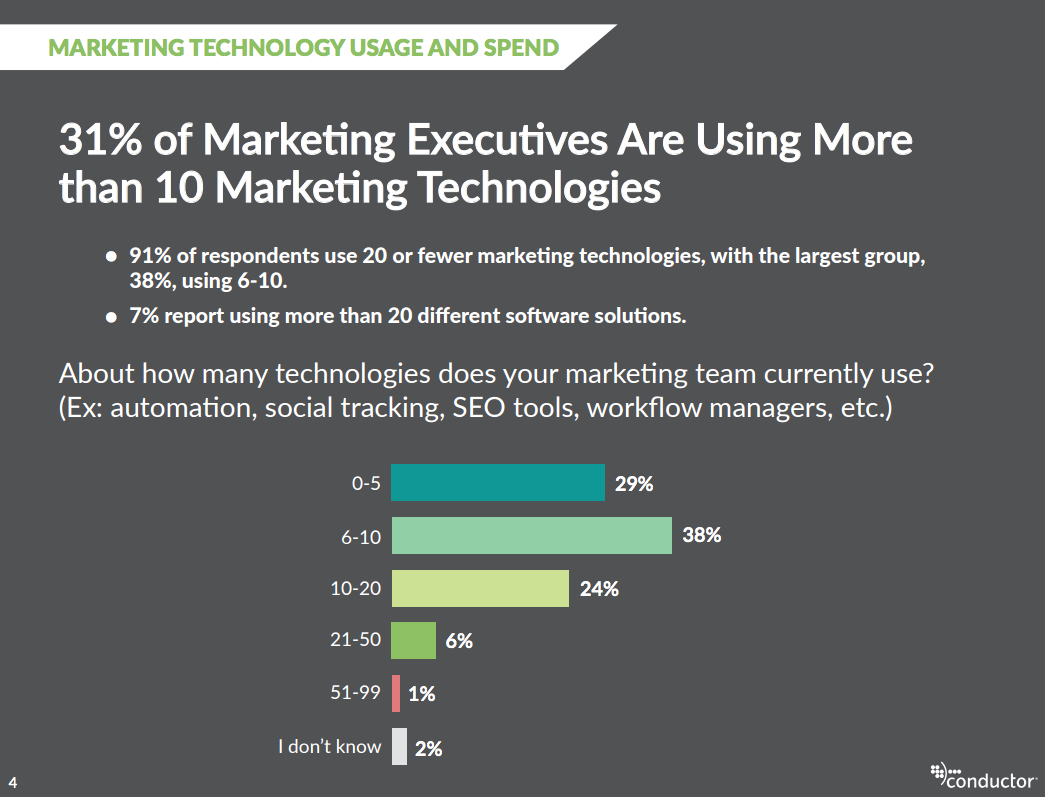Uncategorized
How to (Finally) Simplify Your B2B Marketing Technology Stack
By Kyle Harper on October 17, 2022
The VP of marketing at a B2B technology enterprise sits in her office. The space is cleanly decorated, sparse, and tasteful. On her desk there is only a neat stack of paper, her phone, and her computer. And yet, she couldn't possibly feel more crowded.
On her computer monitor, the logins, dashboards, and control panels of a hundred different pieces of marketing technology crowd the screen. The advertising team is having trouble tracking down a figure, while at the same time the executive board is curious to see a breakdown of the previous quarter's web traffic and lead information. The data team wants a double check a stat they aren't certain is correct, while the web team is equally concerned about a figure that they just discovered is definitely reporting incorrectly—and that is going to affect web reporting as a whole.
B2B marketing today presents thousands of challenges, each of which seems to have between one and fifteen technological "solutions." It's easy for everything to stack up on your team, and before you know it, your marketing mix is a tangle of mismatched reporting, tiresome manual inputs, and arcane pathing that only one person on your team fully understands. But for all of the cost, work, and headache, does all this technology actually help your brand tell its story more effectively?
The Playing Field
It's not hard to understand how we got here.
Between an ever-accelerating pace of competition in the digital space and tech development providing new solutions seemingly every day, the marketing tech space has grown rapidly crowded in just the past 5 years. Between 2011 and 2016, the space for tech providers has grown from 150 tech options to over 3,500 (with recent measurement even leaving out more "general" tech like databasing software). On the one hand, the resulting competition has meant a load of more effective fixes for more marketing problems. On the other, research from Conductor has found this means that 31 percent of marketing executives now report using more than 10 different pieces of marketing technology (with an additional 7 percent of marketing execs reporting that they've broken the 20-pieces-of-tech ceiling).
But these values might not actually be concerning if all of this tech is enabling marketers to do their job better. Right?
The same Conductor study found that this likely isn't the case. Around 53 percent of marketing executives reported feeling "overwhelmed" by the amount of data that their platforms provided, while another 67 percent reported having to move through too many dashboards to find information they wanted. Even just five years ago, the primary challenge for marketers was being able to gather accurate and useful information. Today, our access to information has swung to the other end of the spectrum, and marketers are drowning in it.
The good news? There is absolutely a way to reduce your B2B marketing technology stack. But it's likely going to require some hard evaluation of what your team does, and then a long untangling of the data you already have.
Narrowing Your Criteria
There are two processes you have to go through to simplify your marketing tech situation: evaluate your data questions and evaluate your current tech platforms.
Data questions are simply the questions your team answers by referring to data. In the past, when good data was scarce, knowing exactly what these might be was difficult. The result was often a scrooge-esque hoarding of all data possible, "just in case." Today, however, data science is becoming an increasingly enmeshed part of how enterprise marketers work across the world, and likewise the practices surrounding our approaches to data have become more refined. This enables marketers to focus on what they really need, rather than what they might need.
Evaluate these questions to understand what your brand's data needs really are:
What Do I Have to Justify?
Before any research or analysis, data is used to prove what you know about your brand. Take the time to list out exactly what your team has to report on accurately, before any experimentation enters the mix. Items like conversion tracking and spend attribution fall in here.
What Would I Like to Learn?
Marketers tend to be curious by nature, so it's likely that your answers to this questions will be exhaustive. Once the list is complete however, take the time to group your answers by what sort of data would help you test these hypothesis, and you'll likely find a couple of large groups with a couple of interesting outliers. Wherever possible, try to cut away or tweak your outliers to fit in with your larger groups and it will be easier to choose tech solutions that will help you test most (if not all) of your questions.
Who Will Eventually See This?
Do you report your data to an executive, or does your whole team have access? Are marketers the only people looking at your data, or is it possible you'll have non-marketing professionals trying to interpret your marketing data? Thinking about how your information is presented—or how you might want to avoid it being presented—can help you make decisions between two equally powerful platforms.
Once you've understood what your data needs are, the process of choosing your most efficient marketing tech stack becomes a simple matter of sorting through the marketplace while keeping a few priorities in mind:
- ROI. How can a platform help you better understand how you spend and make money? And does the cost of the platform justify it? This, before anything else, should be your primary choosing criteria.
- Customization and Integration. Marketing moves quickly, and the result is that sometimes platforms can't always meet your specific needs with every update. To prevent having to constantly jump platforms or resort to a daisy chain of intermediate tools, opt for marketing tech that allows you room to customize to your personal needs and integrate easily with your other essential tools.
- Ease of Use. If you (or your team) don't like using the platform, it likely won't be as effective as you would hope. Considering ease of use and presentation after you've taken in the essentials of how a tool actually operates should always be on your mind as you choose.
- Seek a Single Consolidator. Last but certainly not least, several technologies have entered the playing field specifically to help marketers avoid the "too many dashboards" syndrome. If there's room in your stack and your budget, consider adopting one of these reporting platforms to pull all your material into one easily accessible place. Keep in mind however that these platform will likely require a lot of up-front time investment to get set up well. If your stack is sufficiently trim (less than five tools) this sort of consolidation is likely superfluous. Looking for an all-in-one enterprise content publishing solution?Check out the Skyword Platform.
Marketing tech is only going to get more complex. The digital world is full of needs that companies are hoping to solve, and the result is that your brand is already caught in the middle of too many options that do too much or too little to actually matter. The only way to keep ahead of the curve is to remember your human element: keep your curiosity and your needs in mind, and focus on the tech that covers those needs efficiently.


